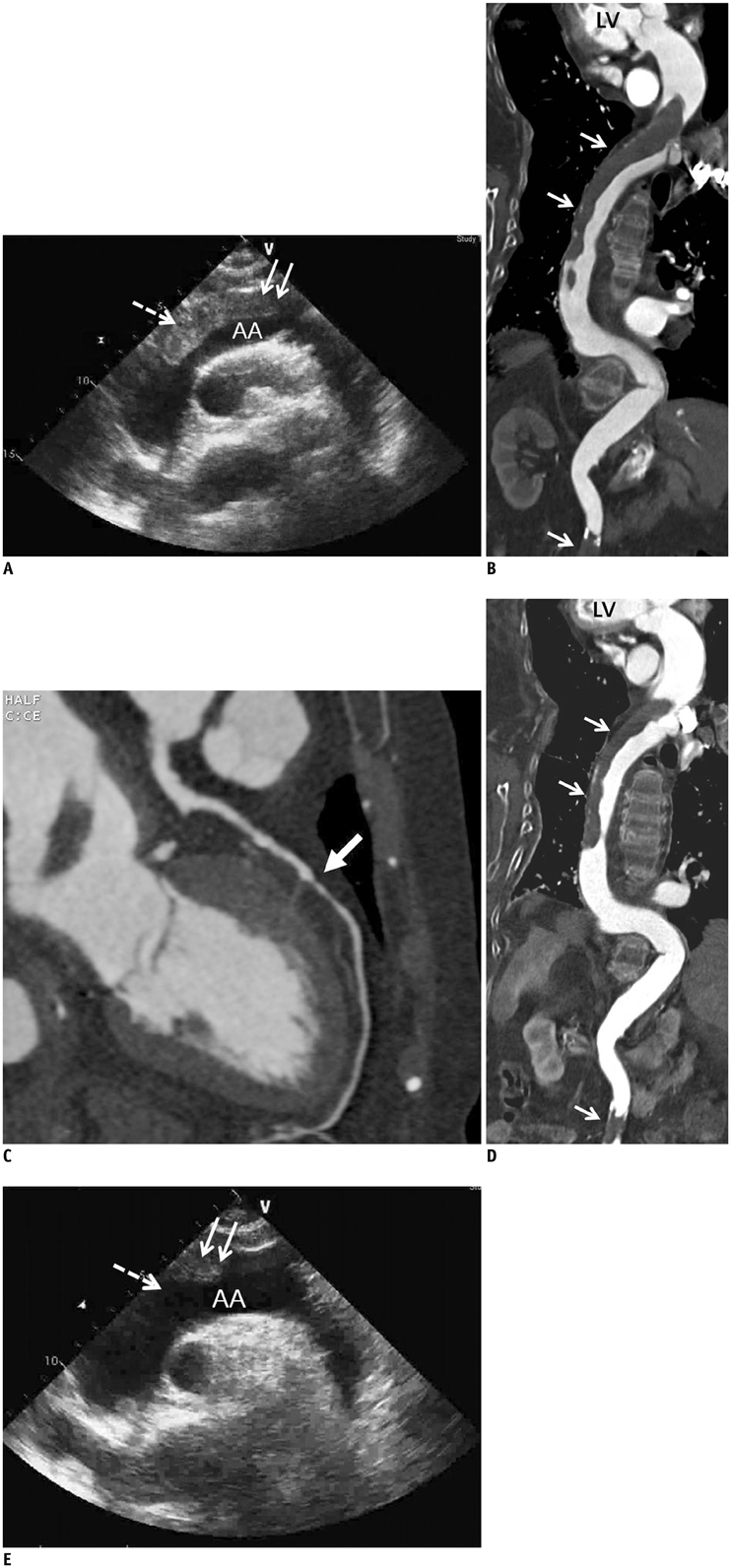Korean J Radiol.
2014 Oct;15(5):637-640. 10.3348/kjr.2014.15.5.637.
Massive Thoracoabdominal Aortic Thrombosis in a Patient with Iatrogenic Cushing Syndrome
- Affiliations
-
- 1Department of Radiology, Chosun University School of Medicine, Gwangju 501-717, Korea.
- 2Department of Internal Medicine, Chosun University School of Medicine, Gwangju 501-717, Korea. dhchoi@chosun.ac.kr
- 3Department of Internal Medicine, Mokpo Jung-Ang General Hospital, Mokpo 530-830, Korea.
- KMID: 1734949
- DOI: http://doi.org/10.3348/kjr.2014.15.5.637
Abstract
- Massive thoracoabdominal aortic thrombosis is a rare finding in patients with iatrogenic Cushing syndrome in the absence of any coagulation abnormality. It frequently represents an urgent surgical situation. We report the case of an 82-year-old woman with massive aortic thrombosis secondary to iatrogenic Cushing syndrome. A follow-up computed tomography scan showed a decreased amount of thrombus in the aorta after anticoagulation therapy alone.
Keyword
MeSH Terms
Figure
Reference
-
1. Adams C, Nagpal AD, Forbes TL, Lawlor DK, Chu MW. Spontaneous aortic arch thrombus presenting as acute critical limb ischemia. Vasc Endovascular Surg. 2010; 44:309–311.2. Pousios D, Velissaris T, Duggan S, Tsang G. Floating intra-aortic thrombus presenting as distal arterial embolism. Interact Cardiovasc Thorac Surg. 2009; 9:532–534.3. Soleimani A, Marzban M, Sahebjam M, Shirani S, Sotoudeh-Anvari M, Abbasi A. Floating thrombus in the aortic arch as an origin of simultaneous peripheral emboli. J Card Surg. 2008; 23:762–764.4. Mandegar MH, Roshanali F, Kocharian A. Complicated course consequences of a floating thrombus in ascending aorta. Eur J Echocardiogr. 2008; 9:846–848.5. Hazirolan T, Perler BA, Bluemke DA. Floating thoracic aortic thrombus in "protein S" deficient patient. J Vasc Surg. 2004; 40:381.6. Nashel DJ. Is atherosclerosis a complication of long-term corticosteroid treatment? Am J Med. 1986; 80:925–929.7. Irey NS, Norris HJ. Intimal vascular lesions associated with female reproductive steroids. Arch Pathol. 1973; 96:227–234.8. Lamy AL, Roy PH, Morissette JJ, Cantin R. Intimal hyperplasia and thrombosis of the visceral arteries in a young woman: possible relation with oral contraceptives and smoking. Surgery. 1988; 103:706–710.9. Jilma B, Cvitko T, Winter-Fabry A, Petroczi K, Quehenberger P, Blann AD. High dose dexamethasone increases circulating P-selectin and von Willebrand factor levels in healthy men. Thromb Haemost. 2005; 94:797–801.
- Full Text Links
- Actions
-
Cited
- CITED
-
- Close
- Share
- Similar articles
-
- Successful Surgical Treatment for Thoracoabdominal Aortic Aneurysm with Leriche Syndrome
- Kaposi's Sarcoma in a Patient with Iatrogenic Cushing's Syndrome
- A Case of Aortic Dissection Associated with Cushing's Syndrome
- A Case of Cushing's Syndrome
- Spinal Cord Infarction Caused by Non-dissected and Unruptured Thoracoabdominal Aortic Aneurysm with Intraluminal Thrombus


